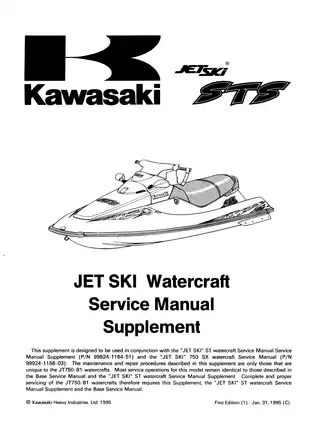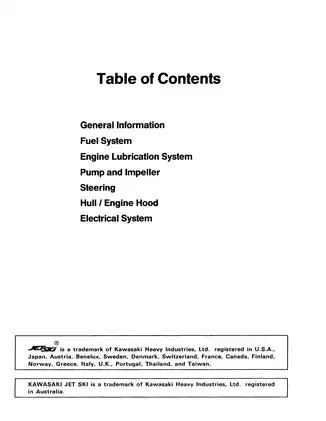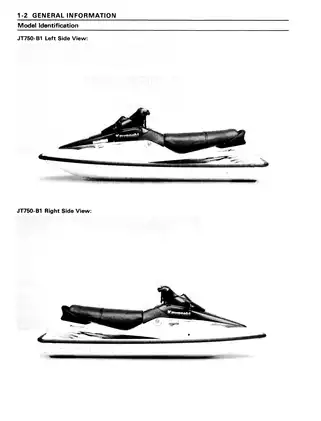Expert Kawasaki JT750 Jet Ski manual, 1994-95 edition
Product Gallery

Sample pages from the Expert Kawasaki JT750 Jet Ski manual, 1994-95 edition manual




Purchase Information
1994-1995 Kawasaki ST, STS, JT750 Jet Ski service manual - Technical Specifications
- Document Number / Seller:
- 26244 / Stephanie Reyes
- File Size:
- 86.14 MB
- File Type:
- ZIP
- Language:
- English
- Printable:
- Yes
- Estimated Download Time:
- 1.76 Minutes
- Delivery Format:
- Digital (PDF) - Instant Access
- Category:
- Jet Ski
- Brand:
- Kawasaki
- Reviewed and Approved:
- Mar 14, 2025
Kawasaki Models and Parts Covered in this Jet Ski Manual
- 1994 Kawasaki ST Jet Ski
- 1994 Kawasaki STS Jet Ski
- 1994 Kawasaki JT750 Jet Ski
- 1995 Kawasaki ST Jet Ski
- 1995 Kawasaki STS Jet Ski
- 1995 Kawasaki JT750 Jet Ski
Complete Manual Information
Table of Contents
General Information
- Model Identification
- Specifications
- Torque and Locking Agent
- Cable, Wire and Hose Routing
Fuel System
- Fuel Tank and Fuel Valve
- Carburetors
- Fuel Pump
Engine Lubrication System
- Engine Oil and Oil Filter
- Oil Pump
Pump and Impeller
- Jet Pump
- Impeller and Drive Shafts
Steering
- Steering System Inspection
- Steering Cable Adjustment
Hull / Engine Hood
- Hull Inspection
- Engine Hood and Seals
Electrical System
- Battery
- Ignition System
- Electric Starter
- Meters and Gauges
- Switches
Appendix
- Troubleshooting
- Wiring Diagrams
- The pricing for this manual is determined by the seller and may vary on different platforms. Please compare prices before making a purchase.
- User comments and ratings on the manual's detail page can aid in your decision-making process. Please consider leaving a review to assist others.
- Don't hesitate to download the repair manual now. You'll receive a lifetime guarantee for the download, as outlined in our FAQs.
- For inquiries about the manual,
Download Instructions for Kawasaki Jet Ski Manual
Frequently Asked Questions - Kawasaki Jet Ski Manual
What does this Kawasaki manual cover?
This comprehensive service manual covers detailed repair procedures, maintenance schedules, troubleshooting guides, and technical specifications for Expert Kawasaki JT750 Jet Ski manual, 1994-95 edition. It includes information for the following models: - 1994 Kawasaki ST Jet Ski - 1994 Kawasaki STS Jet Ski - 1994 Kawasaki JT750 Jet Ski - 1995 Kawasaki ST Jet Ski - 1995 Kawasaki STS Jet Ski - 1995 Kawasaki JT750 Jet Ski .
Is this manual suitable for beginners?
Yes, this Kawasaki manual is designed for both professional technicians and DIY enthusiasts. It includes step-by-step procedures with clear illustrations and safety guidelines for Jet Ski maintenance and repair.
What file format will I receive?
You will receive this manual as a ZIP file (86.14 MB), which is compatible with all devices. The manual is fully searchable and printable for your convenience.
How quickly can I access the manual after purchase?
You'll receive instant access to your Kawasaki Jet Ski manual immediately after payment completion. The download link is valid for 3 days, with lifetime re-download guarantee.
Can I print specific sections of the manual?
Absolutely! This digital manual allows you to print any section you need, from individual pages to complete chapters, making it perfect for workshop use.
Customer Reviews and Feedback
Read what our customers say about this Kawasaki Jet Ski manual and share your own experience.
Add Comment
This policy contains information about your privacy. By posting, you are declaring that you understand this policy:
- Your name, rating, website address, town, country, state and comment will be publicly displayed if entered.
- Aside from the data entered into these form fields, other stored data about your comment will include:
- Your IP address (not displayed)
- The time/date of your submission (displayed)
- Your email address will not be shared. It is collected for only two reasons:
- Administrative purposes, should a need to contact you arise.
- To inform you of new comments, should you subscribe to receive notifications.
- A cookie may be set on your computer. This is used to remember your inputs. It will expire by itself.
This policy is subject to change at any time and without notice.
These terms and conditions contain rules about posting comments. By submitting a comment, you are declaring that you agree with these rules:
- Although the administrator will attempt to moderate comments, it is impossible for every comment to have been moderated at any given time.
- You acknowledge that all comments express the views and opinions of the original author and not those of the administrator.
- You agree not to post any material which is knowingly false, obscene, hateful, threatening, harassing or invasive of a person's privacy.
- The administrator has the right to edit, move or remove any comment for any reason and without notice.
Failure to comply with these rules may result in being banned from submitting further comments.
These terms and conditions are subject to change at any time and without notice.
Comments (4)